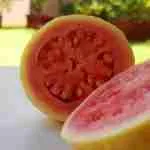You have discovered a strange-looking fruit with an outside that is distinctly red or pink. The inside is white and filled with black seeds. But what is the name of this juicy, exotic fruit?
The Selenicereus undatus, or pitaya blanca, is the only dragon fruit variety with a pink outside and white inside. Other dragon fruit varieties have red skin and pink flesh (Selenicereus costaricensis), or yellow skin with white flesh (Selenicereus megalanthus).
Dragon fruits are commonly found in fruit stalls and supermarkets across the world. The pink-and-white variety (Selenicereus undatus) is by far the most common type of dragon fruit available.
Pink And White Dragon Fruit
With a texture similar to kiwi and a taste as sweet as a pear, the dragon fruit is a popular exotic fruit. They are grown in warmer regions around the world, but are native to Central America.
The tough, scale-like exterior of the fruit gives it its popular name, as it resembles the scales of a dragon. The outside color of the most common variety lies halfway in between pink and red.
Once you open the so-called ‘pithaya’ fruit, its soft but chewy inside is revealed. This is where we find the white flesh. Inside the white flesh, there are dozens of tiny black seeds, which are edible.
Dragon Fruit Varieties
While the pink and white dragon fruit is the most common, other subspecies exist. They are easily distinguishable based on their color. We will discuss the three most common varieties below.
1. White Dragon Fruit (Selenicereus undatus)
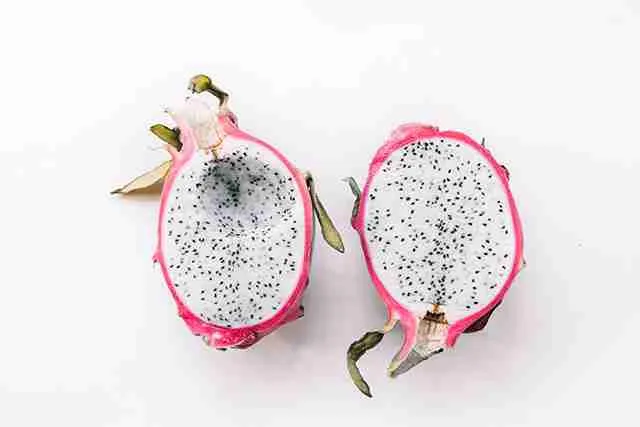
The Pitaya blanca or white dragon fruit is the most common version of this exotic fruit. Most of the large supermarkets will have this cactus fruit stocked on their shelves. It shouldn’t be very difficult to find.
The texture of this white and pink fruit is soft but slightly chewy, similar to a kiwi. It also shares the abundance of many small black seeds. Don’t worry, they can easily be digested and won’t grow a fruit tree in your stomach.
2. Red Dragon Fruit (Selenicereus costaricensis)
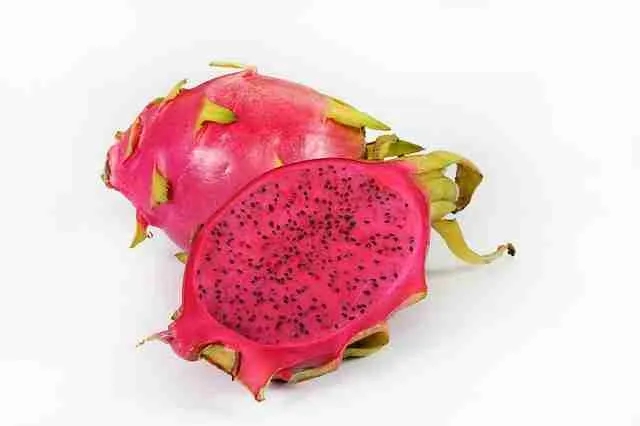
A little more unique-looking is the Pitaya roja or red dragon fruit. While it looks pink with green scales on the outside, the flesh on the inside also has a lavishly pink color. It is one of the most well-known purely pink fruits.
Differences with the more common Pitaya blanca (the white and pink fruit variety) are abundant:
- The shape of the red variety is more round, while the white one is more elliptic;
- The pink flesh on the inside gradually turns more purple as the fruit ripens;
- There are more small black seeds inside the pink flesh;
- The sugar content and sweetness are slightly higher for the red variety.
3. Yellow Dragon Fruit (Selenicereus megalanthus)
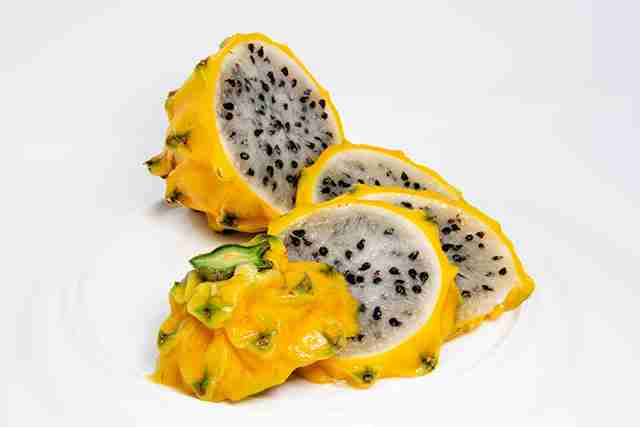
Another variety is the Pitaya amarilla, usually referred to as the yellow dragon fruit. The so-called Ecuadorian dragon fruit is cultivated and most commonly found in Southeast Asia.
Much like the more common Pitaya blanca, the flesh on the inside of this subspecies will have a white color. But there are also some obvious differences from the white dragon fruit:
- The white flesh on the inside looks slightly different, more bright and see-through;
- There are bigger black seeds inside the white flesh;
- The sugar content and sweetness of the yellow dragon fruit are the highest of all varieties.
Are There Other Pink And White Fruits?
You might be reading this and think to yourself — this isn’t the fruit I was looking for at all. It’s definitely not a dragon fruit!
So, which other types of pink and white fruits might exist out there?
We did some extensive research and found the following alternatives. This list of pink and white fruits might contain the foods you are looking for.
Lychee
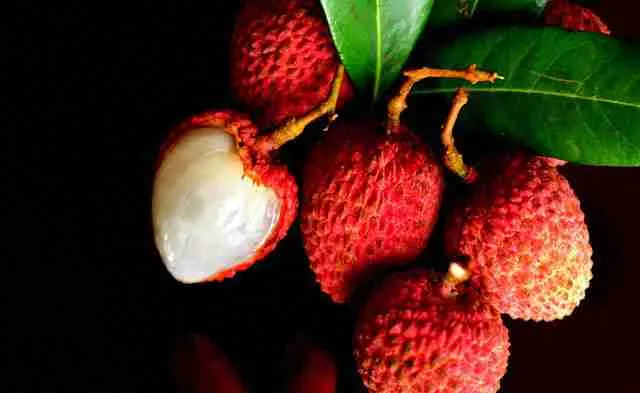
The Lychee (Litchi chinensis) is an oval-shaped tropical fruit from the soapberry family. It is native to Southeast China and has a texture and size similar to a grape.
The flavor of most lychee varieties is sweet and acidic, and it’s commonly sold in supermarkets without its red exterior. The lychee fruit is mainly used in drinks and is a source of vitamins and minerals.
Rambutan
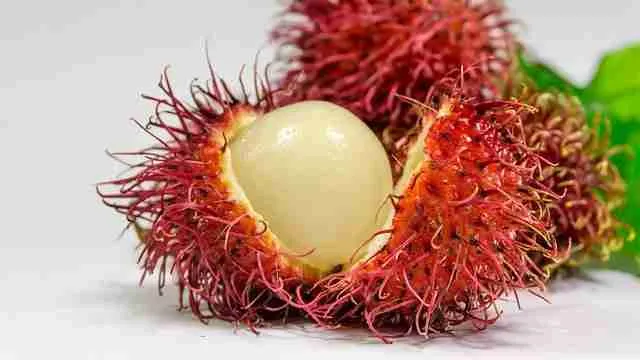
The Rambutan (Nephelium lappaceum) is a fruit that is commonly found in Southeast Asia. It is most closely related to the lychee, which we discussed above.
Rambutans are tropical sweet and sour-tasting fruits from the soapberry family. The exterior is characterized by a chestnut-like appearance. The exterior is clearly red-pink in color, while the fruit itself is white.
Mangosteen
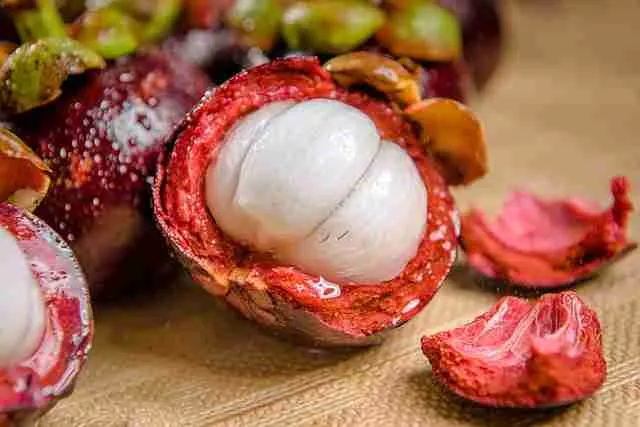
The Mangosteen (Garcinia mangostana) is a tropical white fruit with a purple exterior. The fruit will have a different color based on how ripe it is, and will generally transform from pink to purple over time.
Mangosteens have a taste, sweetness, and texture similar to a banana or peach. The mangosteen will have juicy white flesh, which can be easily taken apart like a mandarin.
Pink Banana
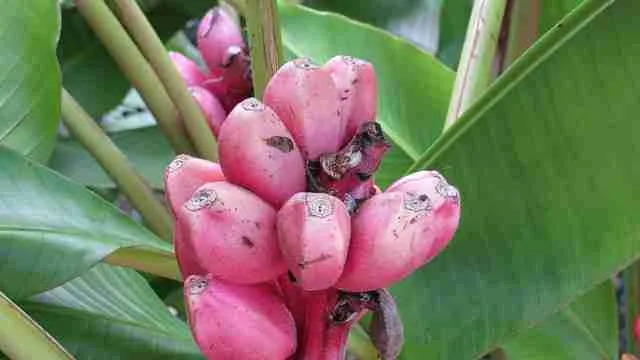
The Pink Banana (Musa Velutina) is exactly what the name suggests: a banana variety with a pink peel. They are originally from the Himalayas mountain region and are more closely related to plantains.
Unlike the yellow bananas you can find in the supermarket, pink ones will have large black seeds in the flesh of the fruit, which are edible.
The taste of this pink fruit is similar to the one we all know and love, but slightly sweeter and more tangy, and with a raspberry-like flavor. They are most often used in desserts.
Rose Apple

Last but not least, the Rose Apple (Syzygium aqueum) might be the fruit you are looking for. The variety shown is the fruit of the so-called ‘Watery Rose Apple’ tree, which is a cherry tree.
These fruits are also known as bell fruit or water apple. They are native to South East Asia and, as the name suggests, contain a lot of water. The juicy flesh is white on the inside, while the thin shell is red.
The fruits are crunchy, slightly sweet, and have a floral note to them. They can be a source of vitamin A, C, and contain plenty of fiber and antioxidants.

